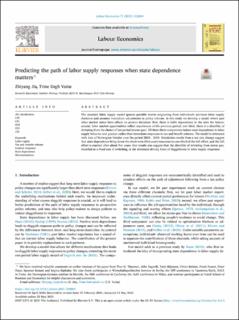| dc.contributor.author | Vattø, Trine Engh | |
| dc.contributor.author | Jia, Zhiyang | |
| dc.date.accessioned | 2022-03-22T18:21:01Z | |
| dc.date.available | 2022-03-22T18:21:01Z | |
| dc.date.created | 2021-08-28T16:59:05Z | |
| dc.date.issued | 2021 | |
| dc.identifier.citation | Jia, Z., & Vattø, T. E. (2021). Predicting the path of labor supply responses when state dependence matters. Labour Economics, 71, 102004. https://doi.org/https://doi.org/10.1016/j.labeco.2021.102004 | en_US |
| dc.identifier.issn | 0927-5371 | |
| dc.identifier.uri | https://hdl.handle.net/11250/2986903 | |
| dc.description.abstract | The standard labor supply model ignores possible inertia originating from individuals’ previous labor supply decisions and assumes immediate adjustments to policy reforms. In this study we develop a model where past labor market status have effects on present decisions: first, there is habit dependence in the taste for leisure; second, labor market opportunities reflect experiences of the previous period; and third, there is a disutility of deviating from the choice of last period (status quo). All these three components induce state dependence in labor supply behavior and gradual rather than immediate responses to tax and benefit reforms. The model is estimated with data of Norwegian females over the period 2003 - 2009. Simulation results from a tax rate change suggest that state dependence bring down the short-term (first-year) responses to one-third of the full effect, and the full effect is reached after about five years. Our results also suggest that the disutility of deviating from status quo, modeled as a fixed cost of switching, is the dominant driving force of sluggishness in labor supply responses. | en_US |
| dc.language.iso | eng | en_US |
| dc.publisher | Elsevier | en_US |
| dc.rights | Navngivelse-Ikkekommersiell-DelPåSammeVilkår 4.0 Internasjonal | * |
| dc.rights.uri | http://creativecommons.org/licenses/by-nc-sa/4.0/deed.no | * |
| dc.title | Predicting the path of labor supply responses when state dependence matters. | en_US |
| dc.type | Peer reviewed | en_US |
| dc.type | Journal article | en_US |
| dc.description.version | publishedVersion | en_US |
| dc.rights.holder | © 2021 The Author(s). Published by Elsevier B.V. This is an open access article under the CC BY license 4.0 | en_US |
| dc.subject.nsi | VDP::Samfunnsvitenskap: 200::Økonomi: 210 | en_US |
| dc.source.volume | 71 | en_US |
| dc.source.journal | Labour Economics | en_US |
| dc.identifier.doi | 10.1016/j.labeco.2021.102004 | |
| dc.identifier.cristin | 1929484 | |
| dc.source.articlenumber | 102004 | en_US |
| cristin.ispublished | true | |
| cristin.fulltext | original | |
| cristin.fulltext | original | |
| cristin.qualitycode | 2 | |

